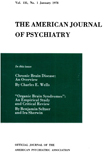Abstract
The relationships between different vanables incident to the program of electric shock treatment and electroencephalographic and clinical effects have been qualitatively and quantitatively worked out for 54 patients receiving such treatment for different types of mental disorders.
Different types and degrees of postshock electroencephalographic changes are noted. In general, the degree of electroencephalographic changes varies as the number of shocks administered and inversely as the interval in days between the last shock and the postshock EEG. There are, however, definite individual differences in shock threshold and subsidence time in regard to the degree of postshock electroencephalographic changes and also individual differences in regard to emphasis on some types of postshock electroencephalographic changes, rather than on others, indicating a differential cortical response to shock.
Fifty percent of the cases had normal and 50% borderline-abnormal preshock EEGs. Some having borderline-abnormal EEGs show a marked degree of postshock electroencephalographic changes but the difference between the two groups—the normal and the borderline-abnormal—is not proved significant in this respect. However, those who show some epileptoid features in their preshock EEG tend to exhibit rare or occasional larval spike-and-wave pattern following shock more than the normal group. A definite electroencephalographic similarity between the epileptic and shocked brain is noted.
There is some tendency for the psychoneurosis with obsessive-compulsive features and depression to be more in the borderline-abnormal preshock EEG group than schizophrenia with depression or psychoneurosis with depression.
Following a simple system of weighting degrees of improvement, lack of improvement and relapse, and calculating the index of efficiency of treatment and then the percentage of efficiency of treatment as compared with recovery, it is found that the percentage of efficiency of the electric shock treatment for the group as a whole at the time of discharge is 49% which indicates a definite improvement over the preshock status. A control group of 64 patients receiving no electric shock has demonstrated only 30.5% efficiency of the treatment they received. The difference between the results of these two types of treatment is statistically significant. Seventy-six percent of the patients who received electric shock and who could be followed up between four months and one year following discharge have retained or bettered their improvement status. It is believed that psychotherapy played an important role in the maintenance of the improvement, though not predominantly in its initiation. There is a statistical indication that patients having psychoneurosis with obsessive-compulsive and depressive features and the highest preshock abnormal and borderline EEGs profit by such treatment more as a group than schizophrenia with depression and schizophrenia without depression. There is a suggestion that patients with preshock borderline-abnormal EEGs profit more as a group by shock treatment than those with normal EEGs.
No significant relationship has been discovered between the number of shocks administered and the percentage of efficiency of treatment.
The necessity for working out intimate relationships between different variables in electric shock treatment for alarger number of patients is indicated to help in the proper selection of cases for treatment and the prediction of its success. The treatment of data as utilized in this study would greatly facilitate the comparison of results from different clinics.

